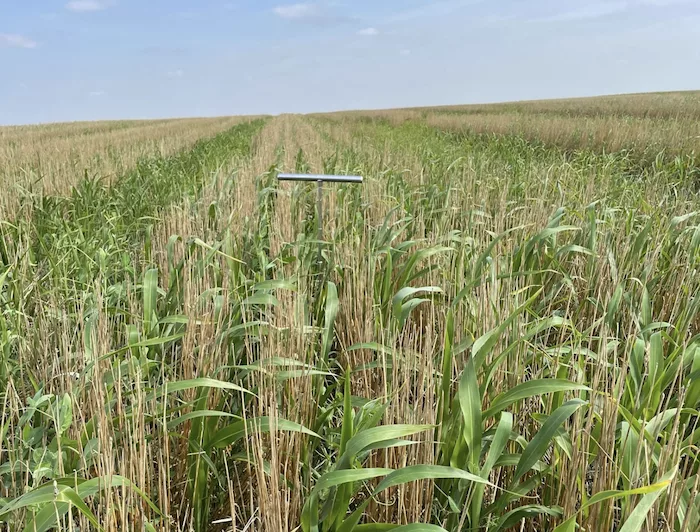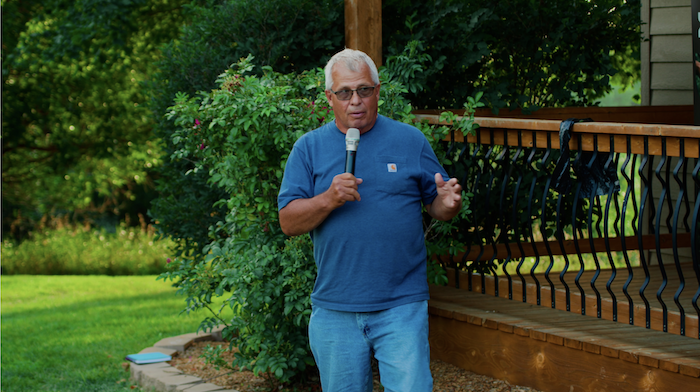
Longtime Cronin Farms agronomy manager Dan Forgey leads a discussion panel during the 2022 Soil Health School near Garretson, SD. He always checks his soil moisture levels using a probe before making final cover crop planting decisions. Photo from SD Soil Health Coalition
Monitor Soil Moisture
Dan Forgey, longtime agronomy manager at Cronin Farms near Gettysburg, SD, finalizes his cover crop decisions by determining how much moisture is already available in the soil.“There’s a lot of people who say, ‘Plant them in dry dirt and it’ll happen.’ I won’t do that because you want your covers to be a success,” Forgey says. “We’re really cautious with our covers on these drier years. I go out with a soil probe. I use the soil probes because then you can actually tell what you have for moisture.”Cronin Farms has a diverse crop rotation, and they normally plant cover crops with higher carbon/nitrogen ratios for grazing after winter wheat harvest.“When we planted our cover last year, it was after harvest. It was probably like the 6th or 7th of August that we planted it, and at that time with the soil probe, we had 16 inches of moisture in our profile,” Forgey says.Forgey thought that was a little dry. He said the farm had received just enough rain that spring and summer to make a good crop, but it wasn’t enough to fully recharge the soil profile. Still, after some careful thought, the Cronin Farms team decided to plant the cover crops anyway.“So, we thought, well, if we caught two or three inches of rain in the fall, that would make up for it,” Forgey says. “That’s what we normally do.”At the time of cover crop planting, he says the available moisture was at 86 percent of normal, so he reduced his seeding rate by a corresponding percentage. The goal is to reduce the number of plants taking up water in the field.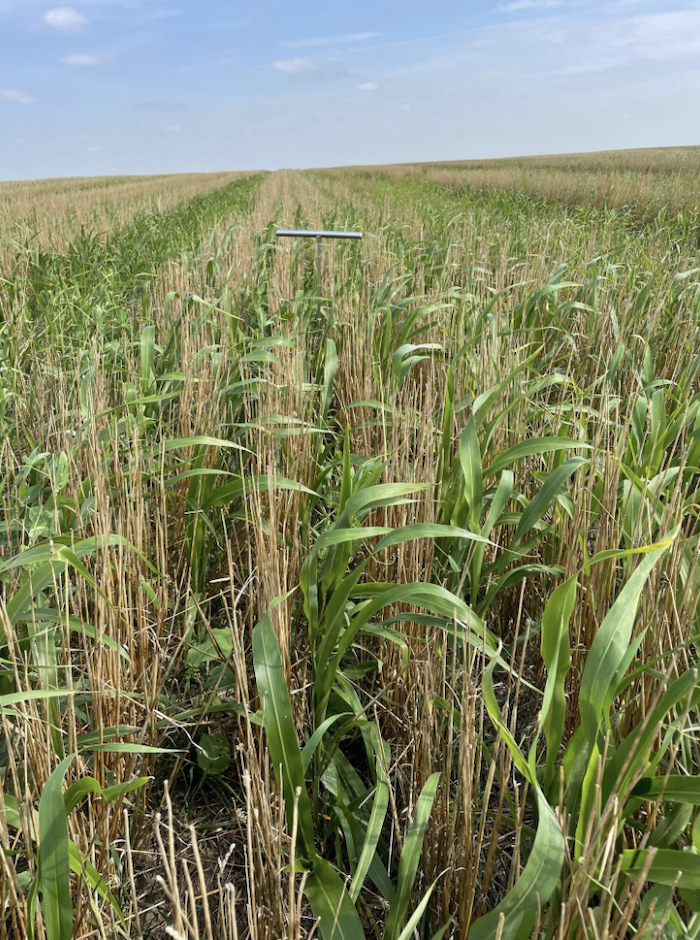
This cover crop at Cronin Farms near Gettysburg, SD, was planted into heavy stubble on Aug. 12, 2022, at which time the field had 16 inches of soil moisture. The crop received no rain after planting, and when this photo was taken on Sept. 25, 2022, the field was so dry that it was difficult to push a soil probe into the ground, and growth on the cover crop had stalled. The yield of the corn crop planted in this field in the spring of 2023 may be affected due to the consumption of soil moisture by this cover crop.
Flexibility
While it’s true that cover crops planted after small grains carry a risk in dry conditions, they can offer a useful flexibility.Selby, SD, crops and livestock producer Doug Sieck planted cereal rye last fall after baling off some oats and peas.“With rye, I plant that in the fall, so people will say, ‘What are you going to do with that?’ And I say to them, ‘I don’t know.’ And I really don’t,” Sieck said. “When spring rolls around, I’ve got the option of grazing it and then plant something behind a grazing. Or maybe I’ll let it grow and plant green into it when it’s knee high and then kill it. Or maybe I’ll cut it for hay like I am now. Or maybe I’ll let it go and combine it. And I’ve done all of those things, sometimes in the same year.”Full Season Covers
Sieck, who is a South Dakota Soil Health Coalition board member, admits that planting a fall cover crop can be a bit of a gamble when it comes to moisture.“If your cover crop uses, let’s say, 3 inches of water, 90 percent of the time you’ll get enough moisture over the winter to replenish those 3 inches. Well, 10 percent of the time you don’t,” he said. “A few years ago I was whining like everybody to [noted Burleigh County, ND, conservationist] Jay Fuhrer, and I said, ‘I don’t have enough moisture to grow these covers reliably,’ and he said, ‘Well, why don’t you dedicate a full season to growing cover crops?’ And so about then I switched mostly to full season covers.”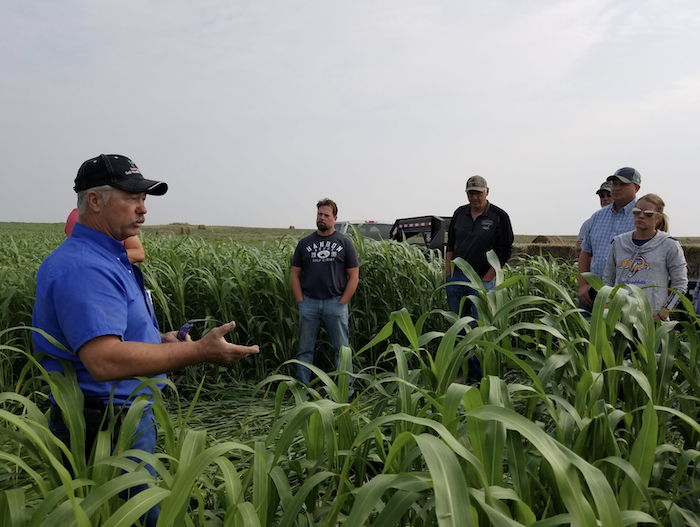
Selby, SD, producer Doug Sieck, left, explains his cover crop choices during a tour of his operation. He now grows mostly full season cover crops due to his moisture concerns. Photo from SD Soil Health Coalition.
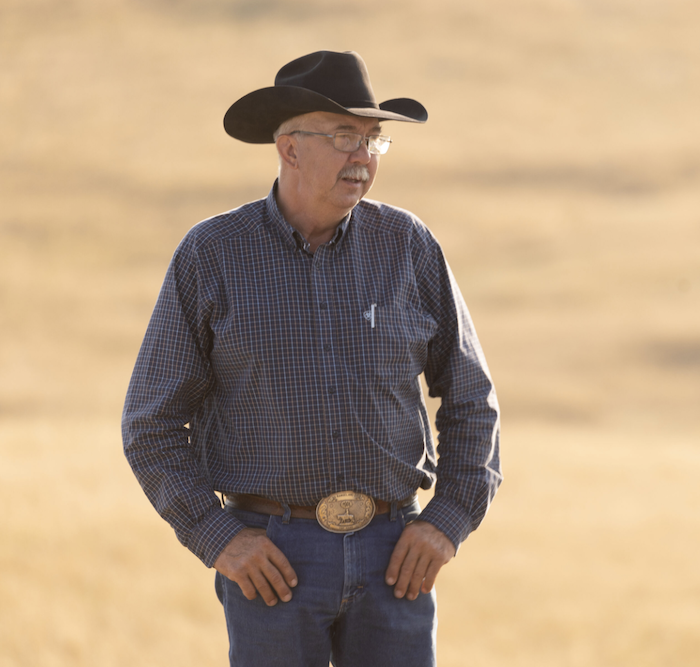
Newell, SD, producer Dave Ollila uses both fall and full season cover crops to feed his cattle and sheep. Photo from USDA-NRCS South Dakota.
Fall Nutrition
Ollila, who is a SDSHC soil health specialist, said he also grows cover crops after harvesting his small grains for hay.“The other way we use them is following a hay, like a cereal hay like oats or wheat, and then we try to get a cover crop to follow into that both to have that living root in the soil, but then, hopefully, to graze that in October,” he said.The reason he likes to graze cover crops in the fall is simple – nutrition.“A lot of times we will breed our ewes on those cover crops because the samplings I’ve taken, the nutrition put us somewhere between 17 and 22 percent protein, which is ideal for that time of year when nothing else is at that level,” Ollila said. “That’s perfect for breeding those ewes.”Well-Researched Decisions
Sieck said that for a cover crop to be a success, producers need to understand the cover crops in their mix and how much moisture they will use.“The guys around here that are that are doing things like covers, a lot of them are reliant on the agronomists at the co-op in town and saying, ‘Well, just fix me up with something.’ Well, that’s a sure recipe to grow a lot of forage out there and lose your moisture,” he said. “I’m a solid yes on planting even if it’s dry, and I’m a solid yes on planting the right thing out there.”“Without a doubt, I believe in covers,” Forgey said. “All I’m saying is understand your system and understand how much moisture you’ve got when you plant your covers.”Related Content:
Improving Soil Health Through Diverse Crop Rotations Including Covers,
Mentorships Share Value of Cover Crops in Cattle Operation,How Strip-Till Can Help Your Operation Survive Drought Conditions
